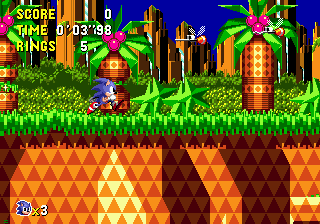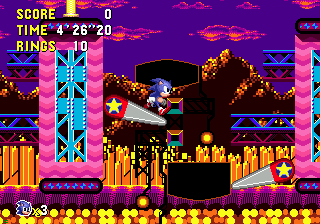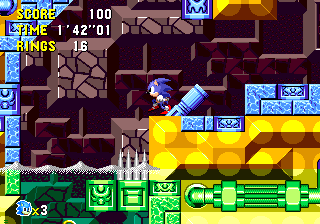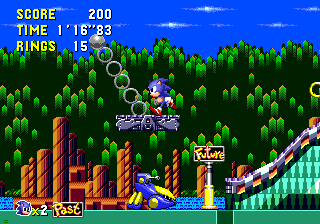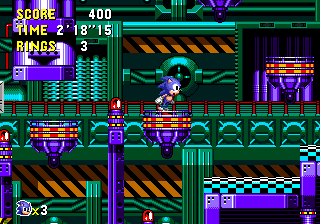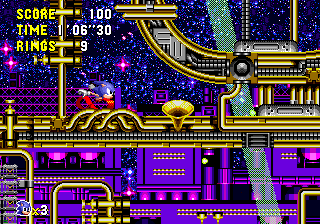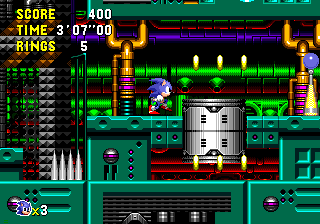
Level Design Notes
At first glance, it seems apparent that Sonic CD borrowed a lot of ideas for its level locations from Sonic 1, as the Green Hill, Labyrinth, Star Light and Scrap Brain Zones all have their own counterparts in this game. Burrow a little deeper into the multiple time zones though, a feature yet to be replicated in any other Sonic game, and you'll usually find whole new and imaginative locations, some rarely seen elsewhere in the series. While futures are mostly somewhat mechanical, pasts often have a prehistoric feel to them, or you can discover that factories and cities were once desert canyons or grand, ancient gardens. There are sometimes even sub-plots to give the levels more personality, such as the single large structure in Stardust Speedway that becomes a different building depending on the time zone, and thus Eggman's rule over it. Achieving a Good Future and seeing how the level will sort itself out in a pleasant outcome is always enjoyable. There really is so much to see, let alone do, in this game.
As I've mentioned, Sonic CD levels are not all about speed, but exploration. While other Sonic levels are designed so that they provide a continuous, fast-paced experience often across a wide area, without too much concern for wasted space on maps, Sonic CD levels are much more efficient in this way. Several routes are often crammed into one set space for any given zone, with few patches of unused areas, to allow for the maximum amount of hidden nooks and crannies. While you can still run through these paths fairly smoothly for the most part, you might find such an experience is a little shorter and less satisfying than the alternative Sonic games that specialise in speed and linearity. Because of the hidden objects you're encouraged to find, such as time travel posts, destructible machines, Metal Sonic holograms or even more rings for Special Stages, these smaller, but more complex level structures are a more suitable design, as they allow the player to be able to backtrack more easily than in a longer and more drawn out level. It's relatively uncommon for there to be any place in a zone that you cannot get to from any other point, at least in one particular time zone or another. This is ideal for offering plenty of opportunity to nose around and find the items you seek, and because of their horizontal size, going back and forth does not necessarily have to take too long. Across the different time zones, structures and objects do vary, but not to the same drastic degree that the appearances tend to. Exact structures of paths and the way in which they connect to each other tend to be the only differences, and this ensures that the time periods feel connected to each other and not like completely separate levels. Level exclusive objects are imaginative and numerous, particularly the clever use of two different types of most enemies; new and old. Bosses are quite unique in that they don't require the usual amount of eight hits during a consistent pattern. Eggman may only need one or two hits at a time to see him off, but actually earning those opportunities and enduring challenges beforehand are what these bosses are all about.
View Notes(3)
Go to..
#1. Comment posted by Tails on Monday, 10th May 2010, 3:13pm (UTC)
#2. Comment posted by Jay on Tuesday, 11th January 2011, 4:00am (UTC)
#3. Comment posted by Anonymous on Saturday, 20th August 2011, 12:15am (UTC)
Hide Notes
A wonderfully bright and happy tropical paradise stage not at all unlike Green Hill Zone. Tonnes of springs will throw you around all over the place and you can spin through crazy winding tunnels or find secret passages in internal rock sections. The Past is a prehistoric jungle while the Good Future has water flowing freely, but the Bad Future is a polluted metal hell. A very short, simple stage that you can whip through with few problems.
Sonic, seemingly, experiments with drugs in his most visually bizarre, backward, psychedelic level in history. This is Sonic CD's standard bouncy/pinball stage (coming in unusually early in the game), with bumpers, flippers, springs and other typical paraphernalia, but the appearance and location of the level is just such a mixed bag of random stuff that it's almost beyond explanation and classification. Amy manages to get herself kidnapped by Metal Sonic at the beginning of the stage, and you must bounce and flip your way to the patience-challenging pinball table of a boss.
Sonic CD's take on the classic Labyrinth Zone, an aquatic cavern level complete with heavy use of typical underwater segments, and winding, narrow passageways loaded with steps and vertical drops. There are plenty of puzzling objects to contend with, including water currents that carry Sonic in one direction, manipulated by switches that also open many a doorway, and lots of tricky moving blocks and spikeballs. Straight paths above the water take you across the most part of the zones, with several gaps to drop down to submerged routes below, and while this is not a fast level, there are a few areas that provide easy time travel between two springs.
Eggman has set up a mine and conveyor belt system to extract Little Planet's quartz crystals, for whatever reason. A pleasant little level that combines underground cavern and outdoor forest environments, where paths are often covered in moving conveyor belts, whose direction can be changed by touching nearby switches. A pretty quick stage with little to worry about, especially compared to either of its level neighbours.
Undeniably an all-time classic contender for the much sought after "stupidest level name" award. In appearance at least, this is a prime example of the mechanical zone type, set inside an industrious Eggman factory. Long checkered bars stretching along the bottom of the stage hurl Sonic up almost across the entire height of it when he touches them, making it difficult to squeeze under the low gaps beneath a series of hanging pillars in Zone 1. Also beware of wide networks of electrifying conduits that light up the background when active, and blasts of freezing air that turn Sonic into a popsicle. The factory is being built against a backdrop of desert canyons in the Past, while the Good Future offers a brighter, fun-factory style experience.
There are few other levels that can both charm and irritate you in such precisely equal quantities as "Star Light Zone on acid", better known as Stardust Speedway. Sonic CD's penultimate stage is by far its fastest, both in terms of top speed and consistency, with pretty much nothing but mind-boggling arrays of thin winding and curving roads, and lots of springs and speed-up devices to both send you on your way, and in the complete opposite direction. Zone 2 features a large background structure that alternates from Eggman statue to tall, beautiful buildings depending on the timezone, and the level culminates in a spectacular highway race against Metal Sonic to finally save Amy from his metallic claws.
Eggman's last stronghold on Little Planet happens to be his biggest and deadliest, and can stand as one of the toughest and most intimidating 2D levels of the series. A Fairly typical final factory lair for the doctor that has bucketloads of obstacles and features, a small number of which in common with Scrap Brain Zone. One of the more memorable is an extremely unique moment in Zone 2, where Sonic has to walk into a laser beam that will shrink him down to half his size, in order for him to fit through tiny passageways! As scary as this place is, you wouldn't want to miss that though, would you? Successful time travel is a complex challenge, but it all culminates in the final, operatic battle with Eggman to decide the fate of the planet!
Each section of this page allows users to add their own notes to fill in any missing details or supply additional research etc.
View general notes for Stages and Story (1)
#1. Comment posted by Dr Shyam on Monday, 31st May 2010, 6:45pm (UTC)
Hide Notes
Last Updated
Content for this page last edited:
22nd February 2009
Files last uploaded for this page:
22nd February 2009
22nd February 2009
Files last uploaded for this page:
22nd February 2009
Recent Notes
Level Design Notes
Posted by Anonymous on 20th August 2011
Level Design Notes
Posted by Jay on 11th January 2011
General Notes
Posted by Dr Shyam on 31st May 2010
Level Design Notes
Posted by Tails on 10th May 2010
4 notes posted on this page in total
Posted by Anonymous on 20th August 2011
Level Design Notes
Posted by Jay on 11th January 2011
General Notes
Posted by Dr Shyam on 31st May 2010
Level Design Notes
Posted by Tails on 10th May 2010
4 notes posted on this page in total



